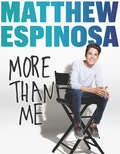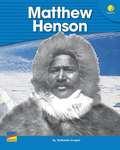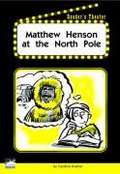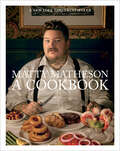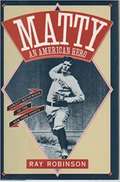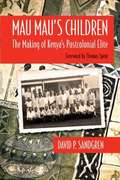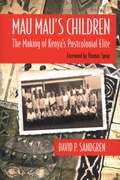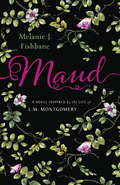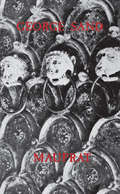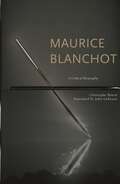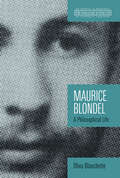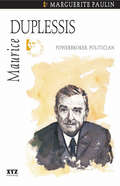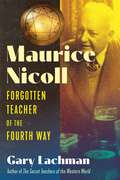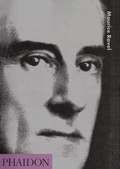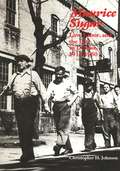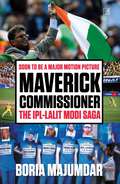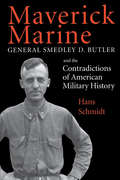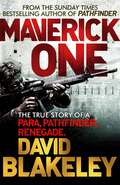- Table View
- List View
Matthew Espinosa: More Than Me
by Matthew EspinosaYou may think you know everything about multiplatform entertainer Matthew Espinosa—but he’s here to tell you so much more in his debut book, full of hundreds of brand-new pictures from a series of exclusive photo shoots.You know Matthew is burning up the internet with more than 18 million fans across YouTube, Vine, Instagram, Twitter, and Facebook. You know about his starring role in the hit movie Be Somebody. And you know he makes you laugh every time.More Than Me tells you what you don’t know, with tons of photos, Q&As, and more that offer an inside look at Matthew’s life and a new side of him that’s hilarious and heartfelt. For the first time, Matthew wants to let the world in on the true story of his wild ride to success and why he loves what he does. In this must-have for any fan, Matthew is ready to share how legendary you can all be—together. More Than Me cover credit Chris Eckert.
Matthew Henson
by Maryann N. WeidtMathew Henson survived poverty and racism as an African American, and he survived the dangers and challenges of the Arctic one of the first people to reach the North Pole. This book tells the story of a man who risked his life to achieve his dreams.
Matthew Henson (Biographies)
by A.M. ReynoldsHow much do you know about Matthew Henson? Find out the facts you need to know about this explorer of the Arctic. You'll learn about the early life, challenges, and major accomplishments of this important American.
Matthew Henson at the North Pole
by Candice Kramer Pam Hirschfeld Karen LeonPerform this script about Robert Peary's discovery of the North Pole and how his assistant, Matthew Henson, played a major role in the expedition.
Matty Matheson: A Cookbook
by Matty MathesonKnown from Viceland and Just a Dash, the acclaimed chef shares personal stories and memories of the food that defined him in this bestselling cookbook. Matty Matheson is known as much for his amazing food as his love for life, positive mental attitude, and epic Instagram account. This debut cookbook is about Matty’s memories of the foods that have defined who he is. With a drive to share his zest for life, he creates dishes within these pages that reinterpret the flavors of his youth in Canada, as well as the restaurant fare for which he has become so well-known. Interpretations of classics like Seafood Chowder, Scumbo: Dad’s Gumbo, and Rappie Pie appear alongside restaurant recipes like Bavette, Pigtail Tacos, and his infamous P&L Burger. This is a very personal cookbook, full of essays and headnotes that share Matty’s life—from growing up in Fort Erie, exploring the wonders of Prince Edward Island, struggling and learning as a young chef in Toronto, and, eventually, his rise to popularity as one of the world’s most recognizable food personalities. His no-nonsense approach to food makes these recipes practical enough for all, while his creativity will entice seasoned cooks. This book is like cooking alongside Matty, sharing stories that are equal parts heartwarming and inappropriate while helping you cook dishes that are full of love. Matty Matheson: A Cookbook is a collection of recipes from one of today’s most beloved chefs.A New York Times BestsellerAn Esquire Best Cookbook of 2018
Matty, An American Hero: Christy Mathewson of the New York Giants
by Ray RobinsonWhen all-time pitching great Christy Mathewson died of tuberculosis in 1925 at the age of 45, it touched off a wave of national mourning that remains without precedent for an American athlete. The World Series was underway, and the game the day after Mathewson's death took on the trappings of a state funeral: officials slowly lowered the flag to half-mast, each ballplayer wore a black armband, and fans joined together in a chorus of "Nearer My God to Thee." Newspaper editorials recalled Mathewson's glorious career with the New York Giants, but also emphasized his unstinting good sportsmanship and voluntary service in World War I. The pitcher known to one and all as "Matty" or "Big Six" was as beloved for the strength of character he brought to the national pastime, as for his stunning 373 career victories. "I do not expect to see his like again," said his best friend and former manager, John McGraw. "But I do know that the example he set and the imprint he left on the sport that he loved and honored will remain long after I am gone."
Matzo Balls for Breakfast and Other Memories of Growing Up Jewish
by Alan KingAlan King -- the beloved comic, actor, producer, author, philanthropist, and storyteller extraordinaire -- has compiled a wonderfully readable book about growing up Jewish, with totally original contributions by famous people. Combining warmhearted humor with a prideful nostalgia, these essays discuss life in the Jewish family and neighborhood, being a Jew in a non-Jewish world, Jewish holidays, and discovering the essence of being Jewish.
Mau Mau's Children
by David P. SandgrenIn 1963 David P. Sandgren went to Kenya to teach in a small, rural school for boys, where he remained for the next four years. These were heady times for Kenyans, as the nation gained its independence, approved a new constitution, and held its first elections. In the school where Sandgren taught, the sons of Gikuyu farmers rose to the challenges of this post colonial era and, in time, entered Kenyan society as adults, joining Kenya’s first generation of post colonial elites. InMau Mau’s Children, Sandgren has reconnects with these former students. Drawing on more than one hundred interviews, he provides readers with a collective biography of the lives of Kenya’s first postcolonial elite, stretching from their 1940s childhood to the peak of their careers in the 1990s. Through these interviews,Mau Mau’s Childrenshows the trauma of growing up during the Mau Mau Rebellion, the nature of nationalism in Kenya, the new generational conflicts arising, and the significance of education and Gikuyu ethnicity on his students' path to success.
Mau Mau's Children: The Making of Kenyas Postcolonial Elite (Africa and the Diaspora: History, Politics, Culture Series)
by David SandgrenThrough these interviews, Mau Mau's Children shows the trauma of growing up during the Mau Mau Rebellion, the nature of nationalism in Kenya, the new generational conflicts arising, and the significance of education and Gikuyu ethnicity on his students' path to success.
Maud Powell, Pioneer American Violinist
by Karen A. Shaffer Neva G. GreenwoodBiography of the first American violinist to gain international rank.
Maud: A Novel Inspired by the Life of L.M. Montgomery
by Melanie FishbaneFor the first time ever, a young novel about the teen years of L.M. Montgomery, the author who brought us ANNE OF GREEN GABLES. Fourteen-year-old Lucy Maud Montgomery -- Maud to her friends -- has a dream: to go to college and become a writer, just like her idol, Louisa May Alcott. But living with her grandparents on Prince Edward Island, she worries that this dream will never come true. Her grandfather has strong opinions about a woman's place in the world, and they do not include spending good money on college. Luckily, she has a teacher to believe in her, and good friends to support her, including Nate, the Baptist minister's stepson and the smartest boy in the class. If only he weren't a Baptist; her Presbyterian grandparents would never approve. Then again, Maud isn't sure she wants to settle down with a boy -- her dreams of being a writer are much more important. But life changes for Maud when she goes out West to live with her father and his new wife and daughter. Her new home offers her another chance at love, as well as attending school, but tensions increase as Maud discovers her stepmother's plans for her, which threaten Maud's future -- and her happiness forever.
Mauprat
by George SandA drama of loyalty and passion set against a Gothic background. This novel is said to have inspired Wuthering Heights.
Maurice Blanchot: A Critical Biography
by Christophe BidentMaurice Blanchot (1907–2003) was one of the most important writers of the twentieth century. His novels, shorter narratives, literary criticism, and fragmentary texts exercised enormous influence over several generations of writers, artists, and philosophers. In works such as Thomas the Obscure, The Instant of my Death, The Writing of the Disaster, The Unavowable Community, Blanchot produced some of the most incisive statements of what it meant to experience the traumas and turmoils of the twentieth century.As a journalist and political activist, Blanchot had a public side that coexisted uneasily with an inclination to secrecy, a refusal of interviews and photographs, and a reputation for mysteriousness and seclusion. These public and private Blanchots came together in complicated ways at some of the twentieth century's most momentous occasions. He was among the public intellectuals participating in the May ’68 revolution in Paris and helped organize opposition to the Algerian war. During World War II, he found himself moments away from being executed by the Nazis. More controversially, he had been active in far-right circles in the ’30s.Now translated into English, Christophe Bident’s magisterial, scrupulous, much-praised critical biography provides the first full-length account of Blanchot’s itinerary, drawing on unpublished letters and on interviews with the writer’s close friends. But the book is both a biography and far more. Beyond filling out a life famous for its obscurity, Bident’s book will transform the way readers of Blanchot respond to this major intellectual figure by offering a genealogy of his thought, a distinctive trajectory that is at once imaginative and speculative, at once aligned with literary modernity and a close companion and friend to philosophy.The book is also a historical work, unpacking the ‘transformation of convictions’ of an author who moved from the far-right in the 1930s to the far-left in the 1950s and after. Bident’s extensive archival research explores the complex ways that Blanchot’s work enters into engagement with his contemporaries, making the book also a portrait of the circles in which he moved, which included friends such as Georges Bataille, Marguerite Duras, Emmanuel Levinas, Michel Foucault, and Jacques Derrida.Finally, the book traces the strong links between Blanchot’s life and an oeuvre that nonetheless aspires to anonymity. Ultimately, Bident shows how Blanchot’s life itself becomes an oeuvre—becomes a literature that bears the traces of that life secretly. In its even-handed appraisal, Bident’s sophisticated reading of Blanchot’s life together with his work offers a much-needed corrective to the range of cruder accounts, whether from Blanchot’s detractors or from his champions, of a life too easily sensationalized.This definitive biography of a seminal figure of our time will be essential reading for anyone concerned with twentieth-century literature, thought, culture, and politics.
Maurice Blondel: A Philosophical Life (Ressourcement: Retrieval and Renewal in Catholic Thought (RRRCT))
by Oliva BlanchetteFrench philosopher Maurice Blondel had a tremendous impact on both philosophy and religion over the first half of the twentieth century. He was at once a postmodern critical philosopher and a devout traditional Catholic, trying not only to reconcile these two seemingly disparate factors in his own mind, but also to prove to others that the two must go together. / In the first critical examination of the philosopher’s life Oliva Blanchette tells the story of Blondel’s stormy life confronting an Academy dismissive of religion and a Religion uncomfortable with rational philosophy. This book not only follows his biographical history, but also presents his systematic philosophy, from the beginning of his journey to the culmination found in Philosophical Exigencies of Christianity, the book for which he signed the publishing contract the day before he died. / Maurice Blondel is part of the Ressourcement: Retrieval and Renewal in Catholic Thought series, edited by David L. Schindler.
Maurice Dobb: Political Economist
by Timothy ShenkThis book explores the life of the man whom even his critics acknowledged was one of the world's most significant Communist economists. From his outpost at the University of Cambridge, where he was a protégé of John Maynard Keynes and mentor to students, Dobb made himself into one of British communism's premier intellectuals.
Maurice Duplessis
by Marguerite Paulin Nora AlleynDuring his 18-year reign as premier of Quebec, Maurice Duplessis dominated the province and shaped it to his image. A brilliant orator and a scathing wit, Duplessis exercised complete control over his caucus and the Cabinet. If he couldnt get a vote, he bought it. Politics was the fuel that drove his life. He died on the job.
Maurice Nicoll: Forgotten Teacher of the Fourth Way
by Gary Lachman• Traces the life of Maurice Nicoll, who left a successful career as a psychiatrist in 1922 to study with G.I. Gurdjieff and P.D. Ouspensky• Explores newly uncovered diaries from Nicoll, revealing his mystical sex practices, his shadow self, and new understandings of his unorthodox teachings• Examines the influence of psychiatrist Carl Jung and Swedish scientist and philosopher Emanuel Swedenborg on Nicoll&’s workIn 1922, Maurice Nicoll (1884-1953) abandoned his successful London psychiatry practice and his direct studies with Carl Jung to move his family just outside of Paris to the Institute for the Harmonious Development of Man, a center recently opened by philosopher, mystic, and spiritual guru G. I. Gurdjieff, the founder of the esoteric system that became known as the &“Fourth Way.&” Nicoll went on to become one of the most passionate teachers of the Fourth Way, committing the final three decades of his life to teaching &“The Work&” in his own unorthodox style.In this revealing biography, Gary Lachman draws on recently uncovered diaries to explore the unusual, syncretic approach Nicoll brought to his teaching of the Fourth Way. He shows how Nicoll is unique in having Jung, Gurdjieff, and Ouspensky as teachers and to have known each of these important figures in esoteric history personally, yet—as Lachman reveals—Nicoll was not a blind devotee by any stretch. Lachman shows how Nicoll incorporated elements of Jungian psychology and Emanuel Swedenborg-inspired mysticism into his exploration and teaching of both Gurdjieff&’s and Ouspensky&’s ideas, as well as into his own best-known work, Psychological Commentaries on the Teaching of Gurdjieff and Ouspensky.Lachman reveals the unorthodox side of Nicoll in fuller detail than ever before through excerpts from recently shared diaries, in which Nicoll included detailed accounts of his own solitary &“self-sex&” erotic experimentations to reach visionary states, along with recordings of his dreams and other personal and mystical reflections. The social details of Nicoll&’s life are also examined, including vivid portraits of the occult scene in the early-to-mid-twentieth century and the communal living situations in which Nicoll sometimes resided. Drawing on his familiarity with hermetic practices and his own experiences with &“The Work,&” Lachman comprehensively explores the significance of Nicoll and the novelty of his thought, offering a profound, needed, and sympathetic but critical study of this man so instrumental to the development and legacy of the Fourth Way.
Maurice Ravel (20TH-CENTURY COMPOSERS)
by Gerald LarnerFrom the Pavane pour une Infante défunte to Boléro, much of the music of Maurice Ravel (1875-1937) is among the most accessible of any written during the last hundred years. The man, however, was notoriously difficult to get to know, partly because of his inherent reserve and partly because he concealed aspects of his character even from his closest friends. The author aims to trace the development of the composer's personality not only through events in his life and in the society around him but also through his music, which is more revealing in this respect than is generally believed. Ravel tended to reveal most of himself at times of crisis, such as the outbreak of World War I, and the death of his adored mother in 1917. 'Adversity', the chapter devoted to those years, is a central feature in a book which begins by evaluating the importance of Ravel's mixed Basque and Swiss heredity and then pursues the first part of his life through his childhood in Bohemian Montmartre, his controversial activities as a student at the Paris Conservatoire, and the establishment of his career as a composer fascinatingly interlinked with that of his older contemporary Claude Debussy. A moving description of his war service as a truck driver is followed by an account of the slow recovery from the failure in his health and morale after his mother's death, the period of conflict and reconciliation with the post-war movement represented by Erik Satie and Les Six, and a last decade of international celebrity coinciding with the gradual onset of the illness which silenced him four years before his death.
Maurice Sugar: Law, Labor, and the Left in Detroit, 1912-1950
by Christopher H. JohnsonIt was Maurice Sugar, labor activist and lawyer for the United Auto Workers, who played a key role in guiding the newly-formed union through the treacherous legal terrain obstructing its development in the 1930s. He orchestrated the injunction hearings on the Dodge Main strike and defended the legality of the sit-down tactic. As the UAW's General Council, he wrote the union's constitution in 1939, a model of democratic thinking. Sugar worked with George Addes, UAW Secretary-Treasurer, to nurture rank-and-file power. A founder of the National Lawyers' Guild, Sugar also served as a member of Detroit's Common Council at the head of a UAW "labor" ticket. <P><P> By 1947, Sugar was embroiled in a struggle within the UAW that he feared would destroy the open structures he had helped to build. He found himself in opposition to Walter Reuther's bid to run the union. A long-time socialist, Sugar fell victim to mounting Cold War hysteria. When Reuther assumed control of the UAW, Sugar was summarily dismissed. <P><P> Christopher Johnson chronicles the life of Maurice Sugar, from his roots in Michigan's Upper Peninsula, through his resistance with Eugene V. Debs to World War I, and on to the struggles of the early 1930s to bring the union message to Detroit. Firmly grounded on the historiography of the UAW, Johnson shows the importance of Sugar and the Left in laying the foundation for unionizing the auto industry in the pre-UAW days. He documents the work of the Left in building a Black-labor coalition in Detroit, the importance of anti-Communism in Reuther's rise to power, and the diminution of union democracy in the UAW brought about by the Cold War. Maurice Sugar represents a force in American life that bears recalling in these barren years of plant closings.
Maurizio Cattelan
by Francesco BonamiMaurizio Cattelan is undoubtedly the best known and most controversial contemporary Italian artist. His works include Hanged Children, the sculpture of John Paul II being struck by a meteorite--which was removed from a square in Milan due to public outcry--and, most recently, Finger, which was displayed in front of the Italian Stock Exchange headquarters. All of his works have aroused heated debate in the art world and the general public. Some believe Cattelan is one of the brightest geniuses of contemporary art, while others consider him only a vulgar--yet clever--provocateur. But who exactly is Maurizio Cattelan? Why does everything he creates cause a scandal?Francesco Bonami, who is the curator of numerous exhibitions and has collaborated with Cattelan on many projects, tells the true story, from the beginning of Cattelan's career to his current resounding success. In this officially unofficial biography, Maurizio Cattelan plays along and tells his story through Bonami, offering, as one of his most provocative works yet, his point of view on art and society--one that, as always, will have people talking.
Maverick Commissioner
by Boria MajumdarThe Indian Premier League. Its mere mention forces cricket fans across the world to sit up and take notice. World cricket&’s most valued property has only grown stronger with time. Conceived and implemented by Lalit Modi in 2008, the IPL has forever revolutionised the way cricket is marketed and run globally. Modi had built and orchestrated the tournament by his own rules and after the stupendous success of the IPL, the same rules were questioned by the administration. Modi was subsequently banned for life.How and why did it happen? What went on behind the scenes? How did it all start to go wrong between Modi and the others? Are there secrets that will never come out? This book is all about everything you never got to know. Each fact corroborated by multiple sources who were in the thick of things, Maverick Commissioner is a riveting account of the IPL and the functioning of its founder, Lalit Kumar Modi. Did Modi have a long telephone conversation with a BCCI top brass the day he left India for good? What really was discussed? Is Lalit Modi the absent present for the IPL and Indian cricket?Soon to be made into a film by Vibri Motion Pictures, Maverick Commissioner documents things exactly as they happened. No holds barred and no questions left out. It doesn&’t judge Lalit Modi. All it does is narrate his story. Who is the real Lalit Modi? Let the readers decide.
Maverick Marine: General Smedley D. Butler and the Contradictions of American Military History
by Hans Schmidt&“Traces Butler&’s stormy career . . . As pure biography, Maverick Marine is a colorful story about a swashbuckling establishment-shaker.&”—Publishers Weekly Smedley Butler&’s life and career epitomize the contradictory nature of American military policy through the first part of this century. Butler won renown as a Marine battlefield hero, campaigning in most of America&’s foreign military expeditions from 1898 to the late 1920s. He became the leading national advocate for paramilitary police reform. Upon his retirement, however, he renounced war and imperialism and devoted his energy and prestige to various dissident and leftist political causes. This biography of Smedley Butler is &“a sympathetic portrait of a Victorian officer-warrior who lost his way as he advanced in rank and his America and his Marine Corps changed after World War I&” (The Journal of American History). &“This long-awaited biography is as crisp as a David Brinkley commentary. Fact-packed and exquisitely documented.&”—Naval Institute Proceedings
Maverick One: The True Story of a Para, Pathfinder, Renegade
by David BlakeleyThe explosive sequel to the bestselling PATHFINDER.For the first time ever an elite British operator tells the gruelling story of his selection into the Pathfinders - Britain's secret soldiers. Pathfinder selection is a brutal physical and psychological trial lasting many weeks. It rivals that of the SAS and takes place over the same spine-crushing terrain, in the rain-and-snow-lashed wastes of the Welsh Mountains. For two decades no one has been able to relate the extraordinary trials of British elite forces selection - until now.Captain David Blakeley goes on from completing selection to serve with the Pathfinders in Afghanistan post 9/11, where he had a gun held to his head by Al Qaeda fighters. From there he deploys to Iraq, on a series of dramatic behind- enemy-lines missions - wherein he and his tiny elite patrol are outnumbered, outgunned and trapped. Maverick One is unique and extraordinary, chronicling the making of a warrior. It culminates in Blakeley fighting back to full recovery from horrific injuries suffered whilst on operations in Iraq, to go on to face SAS selection.
Maverick One: The True Story of a Para, Pathfinder, Renegade
by David BlakeleyThe explosive sequel to the bestselling PATHFINDER.For the first time ever an elite British operator tells the gruelling story of his selection into the Pathfinders - Britain's secret soldiers. Pathfinder selection is a brutal physical and psychological trial lasting many weeks. It rivals that of the SAS and takes place over the same spine-crushing terrain, in the rain-and-snow-lashed wastes of the Welsh Mountains. For two decades no one has been able to relate the extraordinary trials of British elite forces selection - until now.Captain David Blakeley goes on from completing selection to serve with the Pathfinders in Afghanistan post 9/11, where he had a gun held to his head by Al Qaeda fighters. From there he deploys to Iraq, on a series of dramatic behind- enemy-lines missions - wherein he and his tiny elite patrol are outnumbered, outgunned and trapped. Maverick One is unique and extraordinary, chronicling the making of a warrior. It culminates in Blakeley fighting back to full recovery from horrific injuries suffered whilst on operations in Iraq, to go on to face SAS selection.
